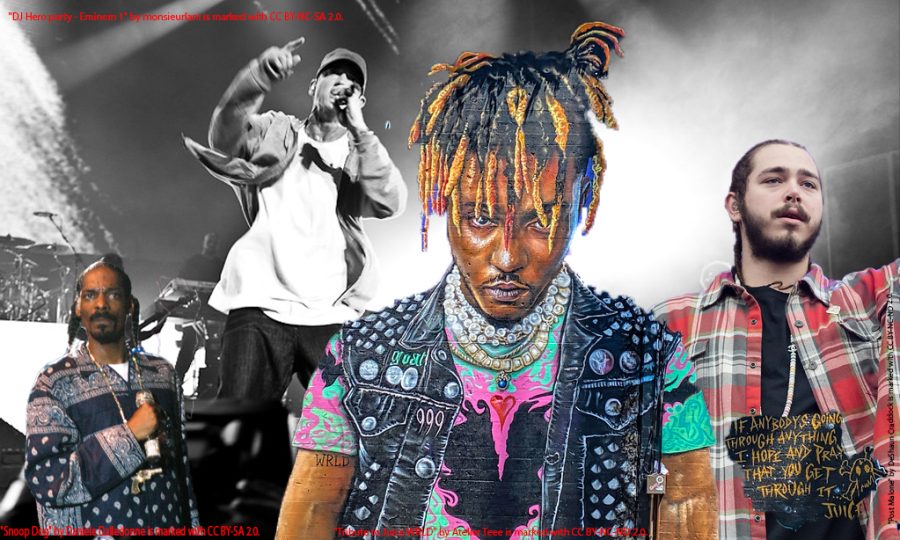The Evolution of Rap Music
April 1, 2022
What began as music to narrate the hardships and culture of “ghetto life” has become one of the biggest and most overpowering genres in the music industry today. Early rappers in the 80s and 90s such as Tupac Shakir and Biggie Smalls rapped about thug life and controversial topics sometimes considered to be rebellious at the time. Even before this, DailyTargum states that, ”The history of rap started in New York City in the 1970s, when DJs started isolating the percussion breaks of soul and disco songs and extended them via looping.” Artists like the Grandmaster Flash and others created DJ beats, interacting with and engaging crowds. As it grew, rap culture was also focused on feuds like the East Coast vs. West Coast and songs highlighted childhood struggles in the area and the conditions that many rappers grew up in. Rap music was one of the first platforms where topics of violence, racism, and minority hardship were able to receive recognition.
Over time, rap music has become more popular and accepted across bigger populations. Instead of solely trying to attract the attention of a record label, upcoming rappers can gain listeners from other music platforms such as Soundcloud. Rap now covers many more topics and has evolved to include more stories, instead of just lyrical narratives about gangster life. For example, according to Harvard Politics, “Ramirez pinpoints the origins of this transition to the release of Kanye West’s 2004 debut album, ‘The College Dropout.’ Rather than focusing on drug dealing or violence or living on the streets, the album addressed religion, West’s pursuit of music, and as he says on the track ‘Breathe In Breathe Out,’ his desire to ‘say something significant.’” Many also associate Kanye West with this big change, with Redbull saying he “paved the way for rappers who didn’t have stories coloured by socioeconomic struggles or violence. Rappers came to be tastemakers, fashion designers and A-listers.”
This transition directly connects to the change in style of rappers over time. Today, the fashion of rappers is more focused on high quality name brands, sometimes flaunting riches and wealth. Senior Avery Knirk described recent rappers’ fashion as “street wear, very on trend, and hypebeast.” Along with fashion, rappers are different today because they have been able to take inspiration from rappers before them and from other genres, such as modern pop and rock. As previously stated, streaming has allowed for rap music to gain even more popularity and for artists to express their styles more freely, as well as reach larger audiences. Sophomore Sarah Dutra states,“It is easier to become successful in the rap industry today because more people can create and publish their own music.” According to Complex, this also means that “the traditional timeline of turning an album in weeks or months in advance no longer applies, and artists can indulge their perfectionist (or procrastinator) tendencies by working up until the last possible moment.” Because of this, music is more perfectly crafted and thought out, which may question the sincerity of the artist and songs. This also allows for more features by other artists in the industry. Collaborations between famous rappers are often very popular and help gain media attention.
Rap music in its earliest forms was known for its honesty, though this can still remain in current rap music. Although the genre sometimes has a bad reputation due to its occasional vulgar or explicit language, rap music carries with it themes that deeply relate with its listeners and highlights important issues that other genres might not even cover. Freshman Roger Bowman says that rap music “can help kids have something to relate to or an escape and it can also help with their confidence.” Rap music certainly never censors the truth, and it has continued to address social issues as they have become more prevalent recently. For example, Harvard Politics says that “rappers such as Macklemore have hits about formerly taboo subjects like homosexuality.” Although songs do not always follow the same theme of the shared gangster life, and instead more of an individual artist’s journey, they are still well thought out and crafted, relating to a larger audience. Its prevalence among high school students is strong because of this. Junior Bennett Jones says that rap music “is one of my favorite genres and most of my friends listen to it too.” While the lyrics can sometimes be intended for mature audiences, the sole purpose of rap music is and was to bring a community together.
Whether you enjoy rap music or not, there is no doubt that its roots came from a place of meaning, revolution, and power. Rap music over the years has been able to rule over the music industry and continue producing new and diverse material. A small community was able to create an entirely original genre focusing on their own lives and struggles, and build up a platform for many successful creators in the future.


